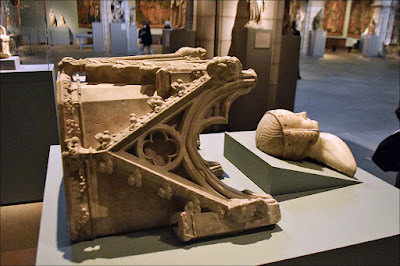 |
| Aquamanile in the form of a Knight on Horseback, copper alloy, German, Lower Saxony, probably Hildesheim, made about 1250 |
Have you ever woken up one morning and said, “I need to see Medieval art today”? As those who know me can vouch, that happens to me quite often. For obvious reasons, unlike our brethren in our ancestral homeland, we New Worlders have limited access to many of our ancient art forms. However, being a New Yorker we are fortunate to have several world-class institutions with amazing historical treasures. Grabbing a friend, we debated between the Metropolitan Museum of Art and the Cloisters and decided to go to the Met simply because it was closer. We plan to visit the Cloisters shortly.
During our visit, most of our time was spent in the Medieval Art and European Sculpture and Decorative Arts galleries admiring their extensive Byzantine and medieval collections, but we had to make a short detour into the Greek and Roman Art Galleries to see the limestone statue of a boxer known as Manneddu (Prehistoric and Early Greek Art, Gallery 150). On loan from Sardinia, until 6 December 2023, the magnificent giant dates from the early first millennium BC. The colossus is one of the dozens of warrior figures unearthed at the necropolis in Mont'e Prama ("mountain of palm trees") located on the western side of the island. The first to be exhibited in these United States, it is a rare opportunity to experience the enigmatic Nuragic civilization and a must-see if you’re visiting the museum any time soon.
It would have been a near-perfect visit if not for the decadent multimedia installation “A Metta Prayer” being projected on the walls of the Great Hall. In the past one could just ignore and bypass unsavory works you weren’t interested in, but we were forced to endure the vile imagery and verse while waiting in line to buy our entrance tickets.
Disappointed by the increase in subpar exhibits and the forthcoming anti-Western “perspectives,” woke revisionist placards that will mar the European Paintings galleries this fall, we showed our displeasure by paying way, way beneath the recommended $30 general admission for New York State residents.
I absolutely cherish the Met, but until they return to a more professional standard of curation, they won’t get another dime from us—literally. Only because we had to pay something, we begrudgingly forked over a penny each for our tickets. Furthermore, we will not be buying anything from their gift shops either. Whenever possible, we refuse to support any institution that works against our best interests, and that includes museums that betray their fountainhead of patronage.
~ Giovanni di Napoli, October 13th, Feast of St. Edward the Confessor
 |
| Limestone statue of a boxer, known as Manneddu, Nuragic, 900-750 BC, Sardinia |
It would have been a near-perfect visit if not for the decadent multimedia installation “A Metta Prayer” being projected on the walls of the Great Hall. In the past one could just ignore and bypass unsavory works you weren’t interested in, but we were forced to endure the vile imagery and verse while waiting in line to buy our entrance tickets.
Disappointed by the increase in subpar exhibits and the forthcoming anti-Western “perspectives,” woke revisionist placards that will mar the European Paintings galleries this fall, we showed our displeasure by paying way, way beneath the recommended $30 general admission for New York State residents.
I absolutely cherish the Met, but until they return to a more professional standard of curation, they won’t get another dime from us—literally. Only because we had to pay something, we begrudgingly forked over a penny each for our tickets. Furthermore, we will not be buying anything from their gift shops either. Whenever possible, we refuse to support any institution that works against our best interests, and that includes museums that betray their fountainhead of patronage.
~ Giovanni di Napoli, October 13th, Feast of St. Edward the Confessor
 |
| Chasse with the Crucifixion and Christ in Majesty, gilded copper on a wood core with champlevé enamel, French, Limoges, made about 1180-90 |
 |
| Chasse with the Life of Christ, gilded copper on a wood core with champlevé enamel and glass, French, Limoges, made about 1235-45 |
 |
| Tabernacle of Cherves, champlevé enamel on gilded copper, French, Limoges, excavated at Château-Chesnel, near Cognac, made about 1220-30 |
 |
| Aquamanile in the form of a Knight on Horseback, copper alloy, German, Lower Saxony, probably Hildesheim, made about 1250 |
 |
| Aquamanile in the form of a Crowned Centaur Fighting a Dragon, copper alloy, German, Lower Saxony, possibly Hildesheim, made about 1200-1225 |
 |
| Gemellion (hand basin) with knight on horseback, champlevé enamel on gilded copper, French, Limoges, ca. 1250-75 |
 |
| Canopy from the Tomb of Philip III (the Bold), King of France, Jean d'Arras (active 1297-1307), marble, French, from the Royal Abbey of Saint Denis, Île-de-France, carved 1297-1307 |
* * *
 |
| (Above & below) Scenes from A Metta Prayer |
 |
| Our receipt |



















